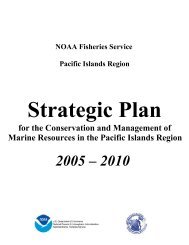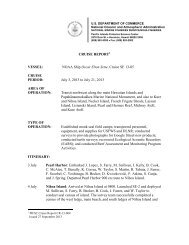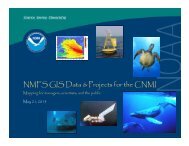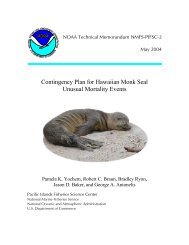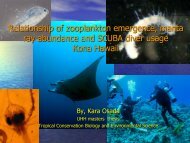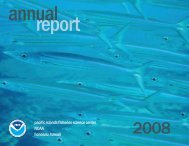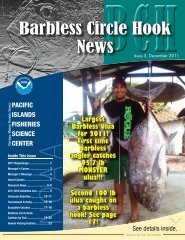Shark Predation on Hawaiian Monk Seals - Pacific Islands Fisheries ...
Shark Predation on Hawaiian Monk Seals - Pacific Islands Fisheries ...
Shark Predation on Hawaiian Monk Seals - Pacific Islands Fisheries ...
You also want an ePaper? Increase the reach of your titles
YUMPU automatically turns print PDFs into web optimized ePapers that Google loves.
Wariness of <str<strong>on</strong>g>Shark</str<strong>on</strong>g>s to Humans<br />
HMSRP also hypothesizes that Galapagos sharks in FFS are wary of humans. A decrease in<br />
CPUE and sightings over time without a coincident drop in incidents support this noti<strong>on</strong>.<br />
Fishing efficiency (removals per effort hours) progressively deteriorated throughout the 2000–<br />
2006 fishing period, when number of hook hours ranged from 10 to 30 hours per seas<strong>on</strong><br />
(Harting et al., in prep.). The sighting rate of Galapagos sharks during the 2001–2004 intensive<br />
tower observati<strong>on</strong> period had declined over time, but the total number of incidents (c<strong>on</strong>firmed<br />
and inferred attacks) did not decline and the number of inferred attacks increased. This suggests<br />
that shark wariness of humans and/or the tower may have c<strong>on</strong>tributed to a decrease in day<br />
predati<strong>on</strong> and an increase in crepuscular and night predati<strong>on</strong> (when observati<strong>on</strong> of attacks is not<br />
possible). Also, there is no history of shark incidents <strong>on</strong> preweaned or newly weaned pups at<br />
Tern, where researchers and USFWS staff reside in a large compound (NMFS, 2003; NMFS,<br />
2004; NMFS, 2005; NMFS, 2008; Harting et al., in prep.). A report <strong>on</strong> shark densities and their<br />
proximity to human populati<strong>on</strong> centers showed a highly significant negative relati<strong>on</strong>ship<br />
between grey reef and Galapagos shark densities and proximity to human populati<strong>on</strong> centers.<br />
High numbers of sharks were prevalent around islands with no human habitati<strong>on</strong> but within<br />
reach of populated areas at <strong>on</strong>ly 15–40% of the populati<strong>on</strong> densities around the most isolated<br />
near-pristine reefs (NMFS, 2009b).<br />
The “human wariness” premise warrants more investigati<strong>on</strong> because human presence may be a<br />
useful shark deterrent itself, as suggested at Workshop II. On the other hand, human presence<br />
may also hamper the effectiveness of some fishing methods. For example, fishing techniques<br />
requiring c<strong>on</strong>stant attenti<strong>on</strong> or maintenance by fishermen may lead to lower catch rates.<br />
Predatory Behavior<br />
A third premise of HMSRP is that any Galapagos sharks sighted in the nearshore areas of<br />
pupping sites (within 50 m of shore given that preweaned pups will range up to 30 m from land<br />
with their mothers) are potential predators of m<strong>on</strong>k seal pups. Galapagos sharks frequent<br />
deeper waters and are rarely found in shallow waters in FFS as dem<strong>on</strong>strated by the CPUE<br />
across the atoll (see Secti<strong>on</strong>s I and II). The majority of Galapagos sharks sighted near Trig and<br />
Gin <strong>Islands</strong> when pups were present dem<strong>on</strong>strated predatory behavior (patrolling, lunging,<br />
chasing and attacking pups) and pursued pups in water as shallow as the wave wash (NMFS,<br />
2003; NMFS, 2004; NMFS, 2005; NMFS, unpubl. data). Circling out from deeper water into<br />
the wave wash is a frequent pattern of the movement of Galapagos sharks observed prior to<br />
attack (NMFS, unpubl. data). Video footage dem<strong>on</strong>strates that some individuals circled<br />
repeatedly for 20 minutes to 2 hours prior to or between attack attempts (NMFS, unpubl. data).<br />
<str<strong>on</strong>g>Shark</str<strong>on</strong>g> Culling<br />
Removing a limited number of Galapagos sharks to mitigate this source of seal mortality likely<br />
facilitates the maintenance of biodiversity at this atoll overall. As an endangered genus,<br />
35




